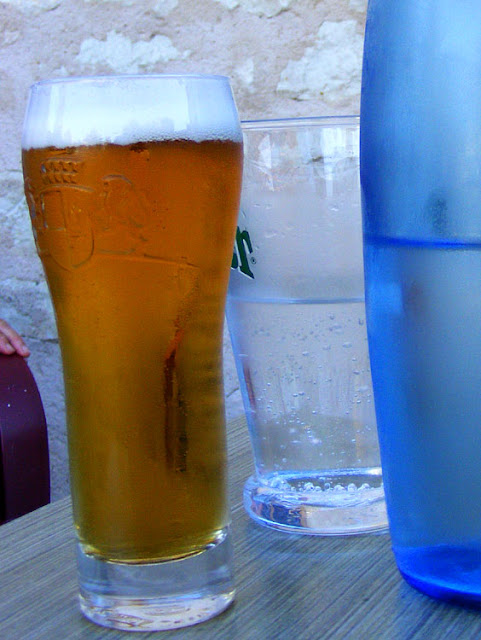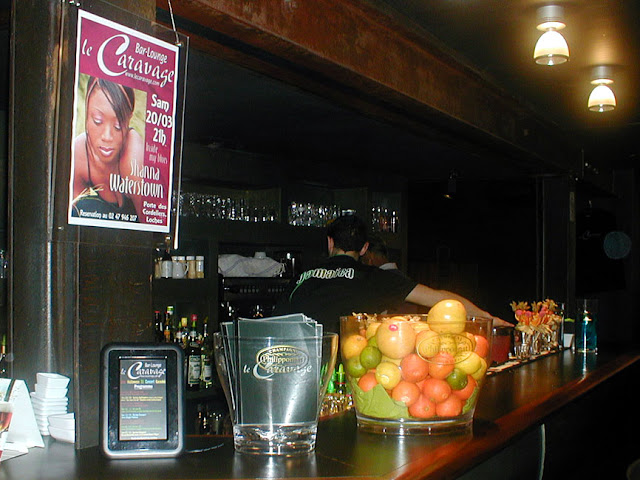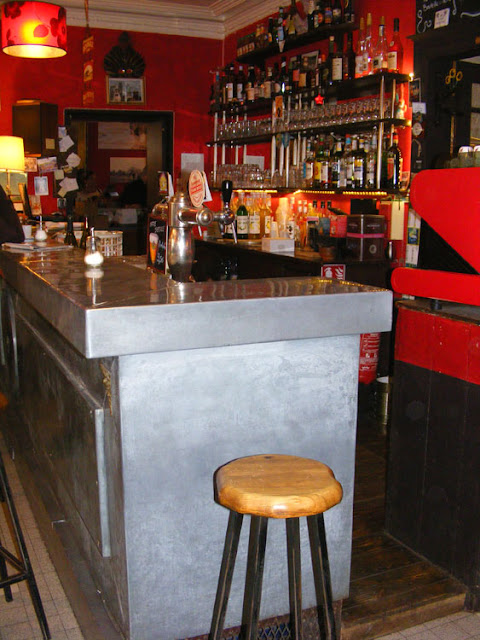The numbers of cafés in France have tumbled, according to a recent study. In 20 years over a quarter of Parisian cafés have disappeared. A symbol of the French 'art of living', they have gone from 1907 in 2002, to 1410 in 2022. France wide, there were 600 000 bistrots in 1960, and 35 000 in 2016. Similar has happened to the roadside restaurants known as routiers. In 1980 there were 4500, today only 700. These types of cafés which operate as bars and bistrots are one of the most iconic aspects of French life, and if they are on the way out, then so is the morning coffee taken at the comptoir, the demi of draught beer in the late afternoon after work and the aperitif in early evening. In the old days this is where you picked up a 'casse-croute' (snack) such as a jambon beurre (ham in a buttered baguette) if you were pushed for time and needed to eat. Another popular snack was a hard boiled egg, which you took from a rack on the bar and banged against the 'zinc' to shell, until it was deemed unhygienic and the practice ceased. Children might have a boiled egg and a glass of milk with grenadine syrup, or a diabolo menthe (mint with limonade). Adults might have a vin limé (wine and limonade) in the summer, or a café-calva (coffee with calvados) in the winter. (Limonade is a still clear sweet drink and is not lemonade.)
 |
| Preuilly was briefly amongst those villages that had lost all its cafés and bars. This is the good old days, at l'Image, with the Chedozeau brothers behind the bar. |
And it is where innumerable conversations on innumerable topics between friends, strangers, and visitors take place. It is where French people would have had their first taste of Coca Cola, in the 1950s. And in the 1960s, televisions appeared, so clientele could watch press conferences with General de Gaulle or the horse races at Longchamp. In the mid-20th century, people would not have had a coffee machine at home and only have consumed Coca Cola at the café, not at home.
 |
| This bar, offering casses-croutes, is in the market hall at Saint Jean de Luz. It offers a robust ambiance not for the faint hearted tourist, but beloved by the regulars. |
The 16th arrondissement in Paris is the most affected, with the loss of 68% of its bars and cafés, followed by the 19th (60% loss) and the 8th (58% loss). Only two arrondissements have increasing numbers of bars and cafés. The 2nd has 17% more and the 3rd has 15% more, due to how popular with tourists they are. Concurrently, fast food outlets and coffee shops are multiplying, and it is this which is contributing to the demise of the bar/café. In the 8th arrondissement there is a 90% increase in the number of fast food outlets, and in the 3rd, an 86% increase. Nowadays, the clientele of cafés and bars are not so much workers, who can't afford them any more, but tourists. The bistrots have become brasseries, the cafés have turned into trendy tea rooms.
 |
| A galopin (125 ml) of draught beer at a bar restaurant in the Touraine. |
But the rise of fast food outlets is not the only reason bars and cafés are disappearing. French workers are taking less time for lunch, not working in the centre of town, and the pandemic didn't help. Many clients have not returned to their old haunts because they now work from home. Even when bars were allowed to reopen once it was deemed safe, initially customers were not allowed to stand at the bar, and that changed consumption patterns too.
 |
| A typical local bar in Preuilly, now also closed. L'Esperance is, or was, opposite the Abbey, and closed in August 2022. |
Ironically, one of the great advantages of the old style bar is the speed of service. Nowadays it is more usual to seat yourself at a table, then wait for the server to come to take your order, and again for them to come with the card machine at the end of your sojourn. Not so good for anyone who just wants a quick drink and has told their wife they are just nipping out to get the daily baguette.
 |
| Le Garage in Saint Jean de Luz, a modern bar which succeeds in being both community oriented and buzzy enough to entice tourists in. |
Sometimes the problem is that bars are in rented premises and the landlord decides to sell the real estate for re-development.
The bar counter is known as a comptoir, often referred to as le zinc. These 'zincs' appeared at the end of the 19th century. They were always set up so they were exactly the right height for a man standing at the bar to lean his elbows on, 110 mm. Even once drunk, men could retain a dignified appearance, propped up by their elbows. Typically the 'zinc' covered bar would be equipped with a beer pump and behind the bar, underneath, there would be refrigerators, with a coffee machine on the other side. Nowadays, many bars are set up in such a way that does not encourage customers to stand propping them up in the old way. Now they are expected to take a table.
 |
| Le Caravagge in Loches, where they do intimate jazz concerts and great mocktails. |
The 'zinc' of the bar is in fact galvinised (zinc coated) steel. Many old 'zinc' bars didn't survive the German occupation of the Second World War. They were requisitioned by the Germans to melt down for munitions. They made a bit of a comeback in the Trente Glorieuses (the 30 years post-World War Two, when France experienced economic growth) but by then formica was the fashionable work surface treatment. Nowadays the 'zinc' (or brushed stainless steel) is back in fashion and formica out, and the patina and lustre of the metal much admired for its practicality, durability and attractiveness.
 |
| A restored zinc bar in Berry. |
In the 1930s there was one bar/café/bistrot for every 85 people. Nowadays it is one for every 1500 people. In the inter-War years these places were where you went for life milestone celebrations (promotions, weddings, birthdays, retirements).
In the early 20th century, absinthe was cheaper than wine. The outlawing of absinthe in 1914 brought a significant reduction to the prosperity of bistrotiers (café owners), as did the outbreak of war and the mobilisation of their clientele (not to mention that so many of them never came back...). It prompted the Pernod brothers to develop the first aniseed flavoured pastis.
Some of the drinks were creatively named (or nicknamed). A 'fond de culotte' is the bitter orange aperitif Suze with cassis (blackcurrant liqueur). It's a sort of French version of Cockney rhyming slang: 'car le fond de culotte ne s'use qu'assis !' (because the seat of the trousers only wears out when sitting, and 's'use qu'assis' is pronounced the same as 'Suze cassis'). A 'soutien gorge' was milk with strawberry syrup, so named because it was the same colour as bras (Fr. soutien gorge) of the time, although sometimes this drink was called a bébé rose (pink baby). A beer is usually a chope (500 ml) or a demi (250 ml), but could be a galopin (125 ml), and can be adulterated with a syrup or cut with limonade like a shandy, in which case it's called a panaché.
Generally speaking, a bistrot is a bar which offers simple dishes, which could be served at the bar. In other words, a pub which offered counter meals.
The etymology of the word 'bistrot' is still disputed. Some people think it is a corruption of a regional word which arrived in Paris in the 19th century. It might come from a Poitevin word 'bistraud', which initially meant a domestic servant, then came to mean a wine merchant. Or it might come from the northern French word 'bistouille' which is a coffee with eau-de-vie added. Or maybe it is from 'bistingo' a slang word for cabaret.
But the popular legend of the word's origin is that it comes from the Russian occupation after the campaign of 1814. The cossacks, stationed in Paris after the fall of Napoleon, would while away their time in the cafés. Fearing discovery by their officers they would cry 'bistro! bistro!', meaning 'quick! quick' when they wanted a drink. The exoticism of the word appealed and many cafés were renamed. The problem with this explanation is that it appears that the first usage of the word only dates from 1884.
And maybe it is 'bistroquet', which is actually a portmanteau word, combining 'bistrot' and 'mastroquet' or 'troquet', a 19th century word from the Flemish for 'cabaret master' or 'bar', and first used in 1926.
Women who remember the good old days of traditional 'zincs' are not always so overcome with nostalgia. They were a haven for alcoholism, and definitely male dominated. And of course, the smoking ban has inevitably altered the atmosphere in these places, with conversations being interrupted whilst the smokers exit for a quick desperate drag (or no longer frequent their local bar at all).

3 comments:
I really miss the French café culture. Lots of style has left us here in the UK with the effect of Covid/WFH.
Comme on dit, on n'arrête le progrès. Nothing is constant but change.
potty: in Preuilly we started a community café.
Ken: yes, but the sort of creeping change that the loss of cafés represents is never welcome when finally it gets noticed. There is some push back which is promising though. Personally, it's the loss of the routiers which I regret the most.
Post a Comment